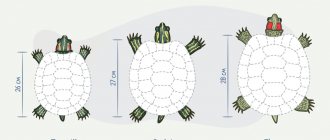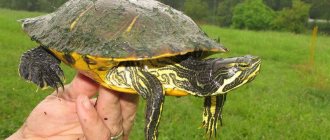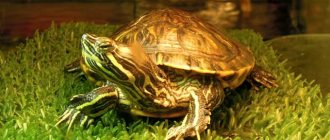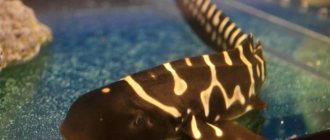Features of choosing food for a turtle
In the early stages, it is quite difficult to train a turtle to come onto land to eat. It is necessary to gradually lure the reptile to the shore so that it is not afraid to accept food from a person and understands that in order to get a treat it needs to get to the shore.
To begin with, you can place the food on the line between the water and the shore. Over time, food can be placed further and further from the water.
Some may think that recommendations on how to properly feed a turtle have no basis, because it would be quite possible to feed the turtle directly in the aquarium without creating any inconvenience for it.
In fact, the disadvantages of such feeding are visible after the first time: the food spoils very quickly in water, begins to rot and clog the water in the aquarium.
You should only resort to this method of feeding a turtle if it categorically refuses to feed on land.
But at the same time, you need to follow standard hygiene rules: clean the aquarium 20-30 minutes after the reptile has eaten, carefully removing all food debris.
How often to feed turtles?
Controversy over reptile feeding frequency is not uncommon. And all because there is no clear answer to this question and the frequency of feeding is individual for each pet. However, there are approximate standards that should be followed. They are valid for both land and aquatic turtles.
- It is recommended to feed young turtles up to 2-3 years old once a day.
- It is recommended to feed adult turtles 2-3 times a week.
What time should you feed your turtle?
It is best to feed turtles in the morning or early afternoon. The timing is due to the fact that these pets lead a predominantly diurnal lifestyle and food is better absorbed before evening. In the evening and at night, when the lamps in the aquaterrarium are turned off, the temperature drops and the reptile's metabolic rate decreases. Therefore, if you feed your pet at night, there is a high risk that digestion will malfunction. This is especially true for land and some aquatic species of turtles (for example, marsh and red-eared turtles). Other reptiles can eat food with equal benefit around the clock.
It is advisable to give your pet food at the same time. Compliance with the regime promotes proper digestion and, as you will see in practice, makes it easier to maintain cleanliness in the aquaterrarium.
How much food should I give my turtle?
The ideal serving size is the one that the turtle can handle in half an hour. If after this time there is food left, it must be removed. This way you will prevent contamination of the aquaterrarium.
It is very important not to overfeed your turtle. This is as dangerous to the body as a poor diet. Overfeeding leads to improper growth of the body and shell, and poor nutrition causes exhaustion and shortens the life of the pet. Also, non-compliance with feeding norms is a path to metabolic disorders, lack (or excess) of vitamins and minerals, and therefore developmental pathologies and malfunctions of various body systems.
And the main nuance that gave rise to controversy about the frequency of feeding. If the turtle eats all the food in a few minutes and then continues to search for food, the number of feedings or the size of portions should be increased. If, on the contrary, the turtle cannot cope with the food, you need to either reduce the portion or feed the pet less often.
Observe the behavior of your pets and study their needs. And then very soon you will understand how often and in what quantities you need to feed your turtle.
Treats for turtles
Most species of turtles that can be kept at home prefer live food, such as worms or moths.
Small turtles love this food the most. It is also necessary for animals after hibernation or illness.
Hibernation can last for a turtle from several weeks to 5 months, depending on the size of the reptile.
Newbie mistakes
Inexperienced turtle owners make mistakes that can harm the health of their pet:
- trying to feed the reptile on land;
- throwing food into the aquarium;
- abuse treats;
- use one type of feed;
- use additives not intended for reptiles.
Owners of red-eared turtles must understand that this is an aquatic reptile that does not feed on land. The diet should be varied, consisting of animal and plant foods. Baby turtles should be fed as predators, adults as omnivores.
We invite you to join our Zen channel and group on VKontakte or Odnoklassniki, where new articles for pet owners are published.
Similar articles:
- The soft shell of the red-eared turtle: what is the reason?
- Home for a land turtle
- Menu for Achatina
Photos of turtles
What to feed a land turtle at home
Turtles are classified as omnivores. What does a land turtle kept at home eat? It is advisable to include not only plant foods in the diet. Twice a week you should give a turtle kept at home snails, crickets, and worms. Your pet will happily eat fresh fruits, vegetables and berries: melons, apples, tomatoes, carrots, broccoli. Always balance your turtle's diet. Some of them prefer sweet fruits, which should be alternated with other foods to ensure that their diet is full of nutrients and minerals. Leafy greens are an excellent addition to this animal's diet.
Among the favorite delicacies of turtles are:
- small fish;
- crayfish;
- crickets.
It is advisable to buy turtle food at a pet store to supplement the diet with some vitamins that they lack in captivity.
Feed your pet turtles a plant-based diet:
- clover and dandelions;
- parsley and lettuce;
- carrots and cabbage;
- raspberries and grapes;
- apricots and plums;
- bananas, apples, oranges.
By using these tasty foods in your pet's diet, you can provide her with an ideal environment in your home.
We should not forget that the turtle needs to be fed dry food (sea kale, seeds, champignons, bran, dry yeast, etc.)
Pygmy turtles – do they exist?
Dwarf means very small. Is there such a turtle in nature? It may be a shame, but such reptiles do not exist. And even if you are offered to buy a dwarf turtle, the size of which does not exceed three centimeters, you should know that this is an absolute deception; this species does not exist in nature. Many unscrupulous sellers, and sadly, even in pet stores, pass off baby red-eared turtles as pygmy turtles. And under favorable conditions and a balanced diet, the baby grows up to twenty centimeters. Therefore, it is hardly appropriate to call them dwarf.
The smallest turtle in the world is the Pennsylvania turtle, with a maximum length that does not exceed twelve centimeters. But it lives exclusively in shallow rivers and lakes of eastern America. That is, it is a freedom-loving reptile that lives in natural conditions.
Among aquarium turtles there are also small specimens. Their length varies from six to thirteen centimeters. Reptiles whose size exceeds the designated boundaries are large species and require slightly different maintenance conditions than small turtles. In total, there are several types of small-sized turtles that are perfect for aquarium keeping - these are:
- Flat turtles, their weight is only one hundred to one hundred and seventy grams, their length is about eight centimeters. They do not require much space, so a small aquarium will be enough for them. The main food is moisture-loving plants. They are very popular among lovers of exotic pets because they are very easy to maintain;
- Trailing turtles grow to a maximum of thirteen centimeters. Their homeland is North America and Africa. Represented by four subspecies;
- Musk turtles are also popular as pets. Their size varies between fourteen and fifteen centimeters. Taking care of them is not at all difficult. This miniature turtle comes in four species;
- Spotted turtles are an amphibian species. To keep them at home, an aquaterrarium is required, since both water and land are required in equal proportions. The size of turtles reaches thirteen centimeters;
- Chinese three-keeled turtles are also miniature species, measuring about thirteen centimeters in size. They feel great in small aquariums.
These are, perhaps, all the small turtles that exist in the world and are suitable for home keeping in aquariums.
Therefore, if you are offered to buy a dwarf turtle without specifying its type, then most likely you will be disappointed in the future, since the reptile will grow up and you will have to radically reconsider the conditions of its maintenance.
As we have already said, babies of the red-eared turtle, which is also popular among breeders of ornamental reptiles, are most often passed off as a dwarf species. And if the purchase has already taken place, then you shouldn’t be upset, because these turtles are also beautiful, so it offers detailed information on how to properly care for your pet so that it fully develops and pleases its owners for many years.











